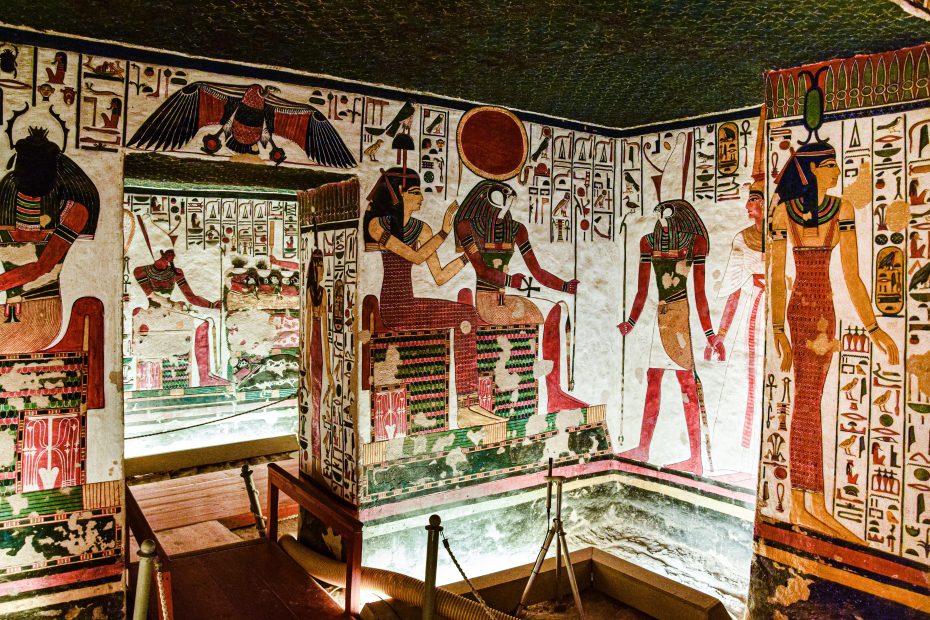Table of Contents
Introduction
Ancient Egypt was a civilization obsessed with death and the afterlife. This obsession manifested in the form of intricate tombs for the dead and vast temples dedicated to the gods. These sacred sites give us a glimpse into the fascinating beliefs and monumental achievements of ancient Egypt. The temples and tombs still standing today are architectural marvels and windows into the past.
Temples
Temples were of utmost importance in ancient Egypt, seen as houses for the gods. Egyptians would make pilgrimages to temple sites to pay homage to their deities, make offerings, and celebrate festivals. The temples were oriented astronomically and designed with precision to align with the path of the sun. Architecturally, they displayed great symmetry and incorporated symbolic imagery of gods.
Architectural Features
Pylons marked the entrance to temples, constructed as large trapezoid stone towers with ornate carvings and hieroglyphics on the facade. They resembled monumental gates guiding worshippers into the temple.
Hypostyle halls followed the first pylon, featuring rows of thick columns that supported the roof. The columns were often engraved with painted hieroglyphics showing scenes of Egyptian mythology.
The heart of the temple was the inner sanctuaries reserved for priests and statues of the gods. This is where daily rituals were carried out.
Well-Known Temples
The Temple of Amun at Karnak is one of the largest temple complexes ever constructed in Egypt, dedicated to the god Amun. Its hypostyle hall has over 120 columns in 16 rows.
The Temple of Horus at Edfu boasts an incredibly well preserved pylon adorned with texts and reliefs. Falcon-headed Horus was worshipped here as the sky god.
At the border with Sudan lies the Temple of Isis on Philae Island. This temple honoring the goddess Isis was saved from flooding by a UNESCO project to relocate it.
Tombs
Providing adequate burial sites was fundamental for ancient Egyptians who believed strongly in the afterlife. Royals and elites were buried in elaborate tombs filled with provisions for the afterlife.
The earliest tombs were mastabas – rectangular mud brick or stone structures partially buried in the desert sand. Eventually, royals desired grander tombs in the form of pyramids.
Pyramids
The most iconic Egyptian landmarks are the Great Pyramids of Giza. These colossal pyramids were built as tombs for the pharaohs Khufu, Khafre and Menkaure during the Old Kingdom.
The Bent Pyramid has a unique shape, beginning with a steep angle then tapering off into a shallower angle halfway up, lending it a bent appearance. It was likely modified partway through construction to prevent collapse.
The Red Pyramid, built for pharaoh Sneferu, is Egypt’s first successful smooth-sided pyramid. Rising 348 feet, it’s the third largest Egyptian pyramid.
Valley of the Kings
Most New Kingdom pharaohs were buried in the Valley of the Kings, located across the Nile from Thebes. Over 60 tombs have been uncovered here, the most famous being Tutankhamun’s tomb discovered intact with treasures untouched by robbers giving invaluable insight into Egyptian burial practices.
Other notable tombs include that of Ramesses VI with its vivid coloring and ceilings depicting celestial representations, and the lavishly decorated Tomb of Seti I.
Preservation Efforts
Many temples and tombs have been unearthed since early archaeology in Egypt took off in the 19th century. While discoveries like Tutankhamun’s tomb gave great insight, early archaeology also damaged sites. thankfully, modern practices are focused on preservation.
Tourism provides needed revenue for preservation but also threatens these ancient treasures through overcrowding. Strict visitor limits are now imposed at popular tombs. Moisture and fungi growth spurred by visitors also damages sites.
The temples of Abu Simbel were saved by a UNESCO project that relocated them above the flood line of the Aswan Dam reservoir in the 1960s. Similar efforts are needed to protect Egypt’s sacred sites against modern challenges. If preserved properly, these architectural wonders will continue enlightening future generations about ancient Egyptian religion, culture and innovation for centuries to come.
Conclusion
The temple complexes and tombs of ancient Egypt offer a bridge between the past and present. While honoring gods and serving as burial chambers thousands of years ago, today they provide modern historians and tourists unparalleled insight into ancient Egyptian society. The architectural and engineering feats of these sacred sites reflect the complex belief system and ingenious capabilities of the ancient Egyptians. Preserving Egypt’s temples and tombs is vital for maintaining this connection to the past and admiring the accomplishments of one of history’s greatest ancient civilizations.
FAQs
Why were temples and tombs significant in ancient Egypt?
Temples and tombs were architecturally impressive, but more importantly they reflected core ancient Egyptian beliefs about gods, the afterlife, death, and celebration of pharaohs.
What are some key features of ancient Egyptian temple architecture?
Key features included pylons, hypostyle halls with engraved columns, inner sanctuaries for priests and statues of gods, symbolic and astronomical alignment, and symmetry.
What is located in the Valley of the Kings?
The Valley of the Kings is a burial ground located on the Nile that contains the tombs of many New Kingdom pharaohs like Tutankhamun, Seti I, and Ramesses VI. Over 60 tombs have been found here.
What challenges exist in preserving Egypt’s ancient sites today?
Threats include tourism overcrowding, lack of resources, moisture damage, urban encroachment, looting, political instability, and the impacts of climate change.
How can tourism positively and negatively impact these historic sites?
Tourism provides revenue for preservation but also threatens sites through overcrowding, introduction of moisture, and wear and tear. Strict visitor limits are necessary.
